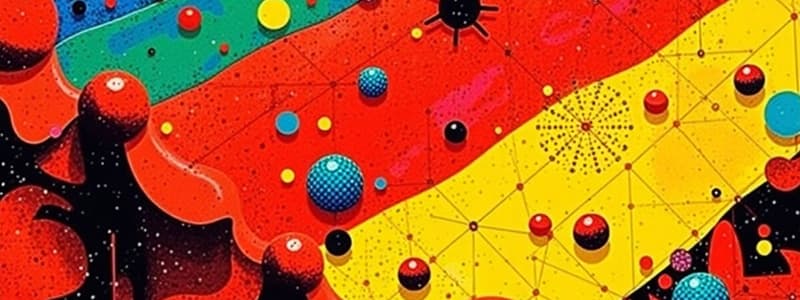Podcast
Questions and Answers
Which ancient artifact provides evidence of the use of nanoparticles for their unique optical properties?
Which ancient artifact provides evidence of the use of nanoparticles for their unique optical properties?
- Medieval illuminated manuscripts
- Egyptian sarcophagi
- Damascus Steel swords
- Lycurgus Cup (correct)
What distinguishes the use of nanotechnology in Damascus steel from its application in medieval stained glass?
What distinguishes the use of nanotechnology in Damascus steel from its application in medieval stained glass?
- Both applications intentionally used nanoparticles, but Damascus steel focused on antimicrobial properties.
- Stained glass relied on silver nanoparticles for structural integrity, unlike Damascus steel.
- Damascus steel utilized gold nanoparticles for coloration, while stained glass used carbon nanotubes for strength.
- Damascus steel intentionally incorporated nanoparticles for enhanced material properties, while stained glass use was likely unintentional. (correct)
How did Michael Faraday's work in the 19th century lay the groundwork for modern nanotechnology?
How did Michael Faraday's work in the 19th century lay the groundwork for modern nanotechnology?
- He developed the first method for creating stable carbon nanotubes.
- He produced the first microscopic images of atoms.
- He synthesized fullerenes, spherical carbon molecules.
- He studied the optical properties of gold nanoparticles. (correct)
Which concept, introduced by Richard Feynman, was pivotal in shaping the field of nanotechnology?
Which concept, introduced by Richard Feynman, was pivotal in shaping the field of nanotechnology?
How did the invention of the Scanning Tunneling Microscope (STM) directly advance the progress of nanotechnology?
How did the invention of the Scanning Tunneling Microscope (STM) directly advance the progress of nanotechnology?
What impact did the discovery of fullerenes ('buckyballs') have on nanoscience?
What impact did the discovery of fullerenes ('buckyballs') have on nanoscience?
How does the application of nanotechnology in medicine differ from its application in electronics?
How does the application of nanotechnology in medicine differ from its application in electronics?
How does the Atomic Force Microscope (AFM) contribute differently to nanotechnology compared to the Scanning Tunneling Microscope (STM)?
How does the Atomic Force Microscope (AFM) contribute differently to nanotechnology compared to the Scanning Tunneling Microscope (STM)?
Which sequence accurately represents the chronological order of these key developments in nanotechnology?
Which sequence accurately represents the chronological order of these key developments in nanotechnology?
What is a key distinction between Norio Taniguchi's definition of 'nanotechnology' in 1974 and the applications of nanotechnology in the 21st century?
What is a key distinction between Norio Taniguchi's definition of 'nanotechnology' in 1974 and the applications of nanotechnology in the 21st century?
Flashcards
Lycurgus Cup
Lycurgus Cup
Ancient Romans used gold and silver nanoparticles to create color-changing effects in the Lycurgus Cup.
Medieval Stained Glass
Medieval Stained Glass
Medieval artists used nanoparticles to create vibrant colors in stained glass windows.
Damascus Steel
Damascus Steel
Damascus steel contained carbon nanotubes, enhancing its strength and sharpness.
Michael Faraday
Michael Faraday
Signup and view all the flashcards
Richard Feynman
Richard Feynman
Signup and view all the flashcards
Norio Taniguchi
Norio Taniguchi
Signup and view all the flashcards
Scanning Tunneling Microscope (STM)
Scanning Tunneling Microscope (STM)
Signup and view all the flashcards
Fullerenes/Buckyballs
Fullerenes/Buckyballs
Signup and view all the flashcards
Atomic Force Microscope (AFM)
Atomic Force Microscope (AFM)
Signup and view all the flashcards
Nanotechnology in Medicine
Nanotechnology in Medicine
Signup and view all the flashcards
Study Notes
- Nanoscience and nanotechnology have ancient roots, with formal study and advancements occurring over the last two centuries.
Ancient Use of Nanomaterials
- Romans (4th century AD) used gold and silver nanoparticles in the Lycurgus Cup, causing it to change color.
- Medieval stained glass used nanoparticles to produce vibrant colors.
- Damascus steel contained carbon nanotubes, contributing to the swords' strength and sharpness.
19th Century Scientific Observations
- Michael Faraday (1857) studied gold nanoparticles and their optical properties.
- Lord Rayleigh researched light scattering by small particles.
20th Century: Birth of Nanotechnology
- Richard Feynman's 1959 lecture, "There's Plenty of Room at the Bottom," proposed manipulating individual atoms.
- Norio Taniguchi (1974) coined the term "nanotechnology" to describe atomic-level precision manufacturing.
Key Inventions in Nanotechnology (1980s–1990s)
- The Scanning Tunneling Microscope (1981) allowed scientists to visualize and manipulate individual atoms.
- Fullerenes/Buckyballs (1985) are spherical carbon molecules that opened new possibilities in nanomaterials.
- The Atomic Force Microscope (1986) aided in studying and controlling nanoscale materials.
21st Century: Rapid Growth and Applications
- Nanotechnology is applied across diverse fields like medicine, electronics, and materials science.
- In medicine, it's used for targeted drug delivery and cancer treatment.
- In electronics, it enables miniaturized chips in smartphones and computers.
- In materials science, it leads to stronger and lighter nanomaterials in construction and clothing.
Studying That Suits You
Use AI to generate personalized quizzes and flashcards to suit your learning preferences.




